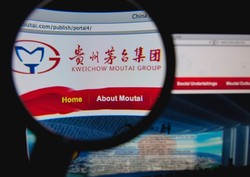NIR spectroscopy could find fake Chinese liquor
Phil Taylor, 18-Jun-2014
 Counterfeiting has undermined the reputation of premium Chinese liquor brands in recent years, but a new study suggests it may become easier to spot the fakes.
Counterfeiting has undermined the reputation of premium Chinese liquor brands in recent years, but a new study suggests it may become easier to spot the fakes.
The liquor - known locally as baijiu or white spirits - has been consumed in China for centuries and with the burgeoning growth in China's economy the market has expanded dramatically to reach an estimated $75m a year. It has certainly helped that the spirit tends to be served at both Communist Party banquets and to seal business deals.
Of late market growth has started to slow, thanks to a crackdown on what is perceived as excessive hospitality in China as well as the deceleration in the country's economy, so liquor producers are now taking greater notice of counterfeiting that eats into sales and profit margins.
Faking and adulteration of liquor - which is typically either diluted or substituted for an inferior product - is affecting both premium brands such as Kweichow Moutai and Wuliangye as well as cheaper products sold in the mid- and low-end of the market. So-called 'age liquor' - a particularly high-grade product - is known to be targeted by counterfeiters.
Now, researchers at Yibin University in Sichuan province have shown that near infrared (NIR) spectroscopy can be used as a screen for counterfeit and adulterated liquor that does away with the need for labour-intensive and time-consuming laboratory analysis.
Use of NIR in the analysis of alcoholic beverages because the signal strength tends to be weak, but the scientists say they overcame this using a chemometric approach that was in turn based on computational tools called ensemble support vector machines (SVM).
The math is too complex to discuss here, but in essence the SVMs serve as statistical tools to increase the accuracy of the analysis and reduce the risk of false positives or negatives.
A sampling study on 120 bottles of liquor carried out by the team revealed that NIR was able to discriminate by variety between commercially available bottles of liquors.
"Nowadays, age liquor is facing a crisis of confidence because it is difficult for consumers to identify the marked age, which prompts unscrupulous traders to [pass] off low-grade liquors as high-grade liquors," they write in the journal Spectrochimica Acta.
While promising, their work should be regarded as a feasibility study, according to the team, and the approach requires "further development with considerably more commercial samples of different varieties before its potential may be realized and adopted by the liquor industry."
Gil C / Shutterstock.com
Related articles:

©
SecuringIndustry.com




 Counterfeiting has undermined the reputation of premium Chinese liquor brands in recent years, but a new study suggests it may become easier to spot the fakes.
Counterfeiting has undermined the reputation of premium Chinese liquor brands in recent years, but a new study suggests it may become easier to spot the fakes.